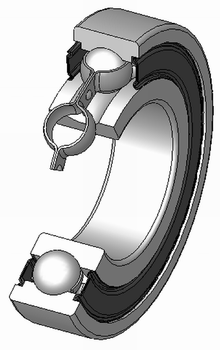
Back محمل دحروجي Arabic Търкалящ лагер Bulgarian Rodament Catalan Valivé ložisko Czech Wälzlager German Rullagro Esperanto Rodamiento Spanish Veerelaager Estonian Errodamendu Basque Vierintälaakeri Finnish
This article may require cleanup to meet Wikipedia's quality standards. The specific problem is: Parts of the article are poorly written/formatted, making for awkward reading. (February 2024) |
This article needs additional citations for verification. (December 2019) |

In mechanical engineering, a rolling-element bearing, also known as a rolling bearing,[1] is a bearing which carries a load by placing rolling elements (such as balls or rollers) between two concentric, grooved rings called races. The relative motion of the races causes the rolling elements to roll with very little rolling resistance and with little sliding.
One of the earliest and best-known rolling-element bearings are sets of logs laid on the ground with a large stone block on top. As the stone is pulled, the logs roll along the ground with little sliding friction. As each log comes out the back, it is moved to the front where the block then rolls on to it. It is possible to imitate such a bearing by placing several pens or pencils on a table and placing an item on top of them. See "bearings" for more on the historical development of bearings.
A rolling element rotary bearing uses a shaft in a much larger hole, and spheres or cylinders called "rollers" tightly fill the space between the shaft and hole. As the shaft turns, each roller acts as the logs in the above example. However, since the bearing is round, the rollers never fall out from under the load.
Rolling-element bearings have the advantage of a good trade-off between cost, size, weight, carrying capacity, durability, accuracy, friction, and so on. Other bearing designs are often better on one specific attribute, but worse in most other attributes, although fluid bearings can sometimes simultaneously outperform on carrying capacity, durability, accuracy, friction, rotation rate and sometimes cost. Only plain bearings are used as widely as rolling-element bearings. Common mechanical components where they are widely used are – automotive, industrial, marine, and aerospace applications. They are products of great necessity for modern technology. The rolling element bearing was developed from a firm foundation that was built over thousands of years. The concept emerged in its primitive form in Roman times;[2] after a long inactive period in the Middle Ages, it was revived during the Renaissance by Leonardo da Vinci, developed steadily in the seventeenth and eighteenth centuries.
- ^ ISO 15
- ^ Hamrock, B. J.; Anderson, W. J. (June 1, 1983). "Rolling-Element Bearings". NASA Technical Reports Server.
{{cite journal}}: CS1 maint: multiple names: authors list (link)
© MMXXIII Rich X Search. We shall prevail. All rights reserved. Rich X Search